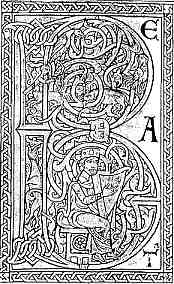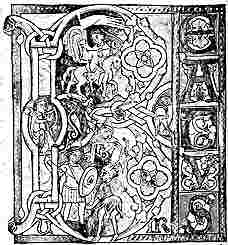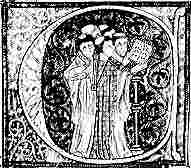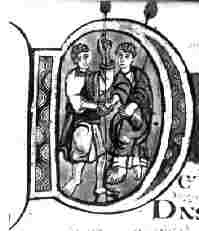 |
|
Initials
and Borders (2) |
|
Some
initials became more elaborate, and also emphasised their function as
a place marker to identify sections of text, with the development of historiated
initials. |
|
|
The
initial at the beginning of the heading in the last example (British Library,
Cotton Vespasian A1, f.31) is reportedly one of the earliest examples
of the type, from the early 8th century. By permission of the British
Library.
|
|
Particular
forms and images were associated with specific parts of the text of standardised
works like the Bible.
The decorative style changed with the fashions of the day. To designate
these as place markers is possibly reducing their function to the ordinary
and banal, when in fact there was a spiritual dimension. The examples
below refer to the beginning of the Psalms,
those songs of praise found not only in their original source of the Bible,
but featured in all the works of church liturgy
and in the book
of hours for the laity. The extravagant BEATUS marks not only the page of a book but a spiritual space. Similarly the
significant In principio erat verbum ... passage at the beginning of St John's gospel
was often singled out for special treatment; a definingly spiritual passage
embedded in the narrative of Christ's life. |
 |
 |
|
Two
examples of the initial B of the word
Beatus which begins Psalm i, both from 12th century manuscripts.
That on the left is from the Melissande Psalter (British Library, Egerton
MS 1139, f.23) and features David playing his harp among twining foliate
ornament and animals, including a lion eating the foliage. That on the
right is from a Bible (Paris Bibliothèque St Geneviève,
MS8-10, vol.ii, f.194) and includes the foliage and an image of David
with his harp along with other scenes. Yes, they would look much more
impressive in colour. |
 |
A
historiated initial illustrates the text in some way, possibly providing not
only a place marker but a mnemonic device to jog the memory. In the example at left the
letter C begins the phrase cantate
domino, which is what the little group of clerics are doing, singing
to the Lord |
|
From the Luttrell Psalter (now in the British Library). |
|
While
initials bore a relationship to the text, borders seem to most often contain
purely decorative elements or those whose significance is related to the
art style and psyche of the era rather than the content of the page. During
the 14th century borders broke out in an extravaganza of mad imagery,
with fantastic creatures, little genre scenes and crazy whimsical anomalies.
Solemn and prestigious works were not immune from this phenomenon. In
fact, they were the most likely subjects for it. It seems to go along
with similarly bizarre representations in church art, where what seem
like inappropriate things appear in holy places. I shall not even attempt
anything so fanciful as to relate it to the famines and plagues of the
era and a desperate attempt to mock gently at God in order to get his
attention. However, if you find a monkey examining a urine flask or a
creature with three heads and no legs standing upside down, you have hit
the era from around 1330. |
|
A
furry footed fiddler makes the bow hair fly in a margin of the Luttrell
Psalter (now in the British Library). |
|
A
monkey examines a urine flask in a 14th century nave window in York Minster. |
 |
By
the 15th century there was a return to floral and foliate ornament, only
with a more naturalistic representation than the twining jungle vines
of the 12th century. That is to say, there was plenty of curling and less
interlacing, but recognisable species of flowers, fruit and sometimes
animals and birds were sprinkled among them. You can put it down to Italian
influences on the more accurate representation of reality, to a growing
interest in the natural world, to a more benign social and natural environment
which requires fewer monsters to scare the demons away, to the commodification
of culture and the moving of prestige goods into the comfort zone. Or
you can just say it's very pretty. |
|
Floral
and foliate border on a leaf from a late 15th century book of hours, by permission
of the University of Tasmania Library. |
|
continued  |
 previous
page previous
page |
 Decoration Decoration |
|
 |
 |
 |
 |
 |
 |






